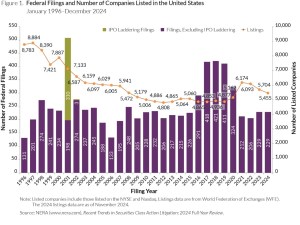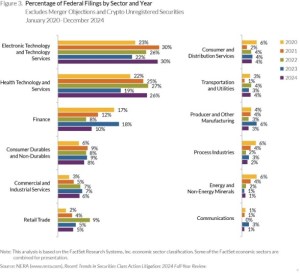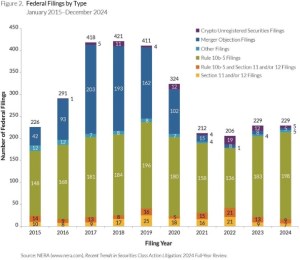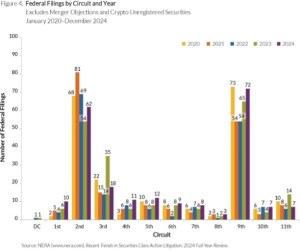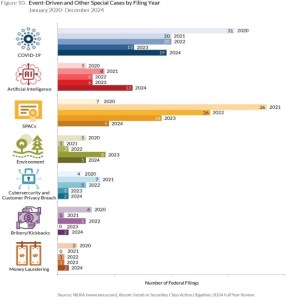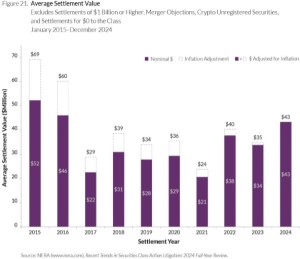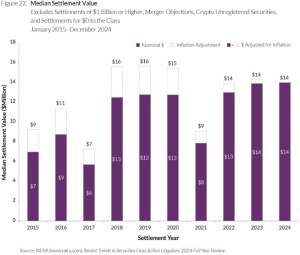In this update:
- We report on orders from the Supreme Court that dismissed two securities-related cases from the Court’s merits docket, leaving unresolved questions about pleading standards and the nature of misstatements under the PSLRA. We also examine one potential circuit conflict involving federal courts’ jurisdiction to hear securities-related cases under the Class Action Fairness Act.
- We cover recent developments in Delaware, including the latest opinion in Tornetta v. Musk, a recent Delaware Supreme Court opinion addressing aiding and abetting liability, and two new opinions addressing litigation over commercially reasonable efforts clauses.
- Lawsuits challenging public companies’ environmental, social and governance (ESG) disclosures and policies continue to be filed, as do cases challenging ESG policies implemented by states, asset managers, and trading platforms. We survey notable developments in securities cases involving ESG allegations.
- The cryptocurrency space has seen considerable activity since our last Update. Below, we discuss noteworthy new case filings and rulings in various lawsuits, as well as other developments that could impact cryptocurrencies going forward.
- We discuss recent cases addressing price impact issues in the wake Goldman Sachs Group., v. Arkansas Teacher Retirement System. We also highlight recent opinions addressingmarket efficiency and preview cases on appeal implicating various reliance- related issues.
- Finally, we address several other notable developments, including a recent opinion from theSecond Circuit addressing materiality, a recent opinion from the Ninth Circuit involving a Special Purpose Acquisition Company or “SPAC,” a Tenth Circuit decision pertaining to short-selling, and recent securities lawsuits implicating Artificial Intelligence.
I. Filing And Settlement Trends
A recent NERA Economic Consulting (NERA) study provides an overview of federal securities litigation filings in 2024. This section highlights several notable trends.
A. Filing Trends
Figure 1 below reflects the federal filing rates from 1996 through 2024. In 2024, 229 federal cases werefiled, matching the number of federal filings in 2023. That figure is considerably lower than in the peak years of 2017-2019, but is consistent with the number of filings from 2021 onwards. Note, however, that this figure does not include class action suits filed in state court or state court derivative suits, including those in the Delaware Court of Chancery.
Figure 1:
B. Mix Of Cases Filed In 2023
1. Filings By Industry Sector
As shown in Figure 2 below, the distribution of non-merger objections and non-crypto unregistered securities filings in 2024, varied somewhat from 2023. Notably, after a dip in 2023, the “Health and Technology Services” sector percentage returned to the percentages seen in 2021 and 2022. Similarly, the percentage of “Electronic Technology and Technology Services” filings increased in 2024, returning tolevels last seen in 2021. Together, “Health and Technology Services” and “Electronic Technology and Technology Services” filings once again comprised over 50% of filings after dipping to 41% in 2023.Meanwhile, “Finance” sector filings decreased from 18% to 10%.
Figure 2:
2. Filings By Type
As shown in Figure 3 below, Rule 10b-5 filings make up the vast majority of federal filings this year. In fact, filings of other types are as low as they have been in years.
Figure 3:
3. Filings By Circuit
Figure 4 provides insight into the distribution of federal filings by Circuit. Most filings occur in the Second and Ninth Circuits. After trending down from 2021 to 2023, the number of filings in the Second Circuit increased this year. By contrast, the number of filings in the Ninth Circuit has remained steady or increased each year since 2021.
Figure 4:
4. Event-Driven And Other Special Cases
Figure 5 illustrates trends in the number of event-driven and other special case filings since 2020. The number of Artificial Intelligence-related filings in 2024, was more than double the number of such filings in2023 and 2022. By contrast, SPAC and Cybersecurity and Customer Privacy Breach filings have decreased steadily since 2021.
Figure 5:
C. Settlement Trends
As reflected in Figure 6 below, the average settlement value in 2024 was $43 million. That is the highest number since 2016, and a significant increase from the mid-year average ($26
million). (Note that the average settlement value excludes merger-objection cases, crypto unregisteredsecurities cases, and cases settling for more than $1 billion or $0 to the class.)
Figure 6:
As for median settlement value, it equaled the values from 2022 and 2023. At $14 million, the mediansettlement value also increased significantly from the mid-year median ($9 million). (Note that mediansettlement value excludes settlements over $1 billion, merger objection cases, crypto unregistered securities cases, and zero-dollar settlements.)
Figure 7:
This post comes to us from Gibson, Dunn & Crutcher LLP. It is based on the firm’s memorandum, “Securities Litigation 2024 Year-End Update,” dated February 27, 2025, and available here.
 Sky Blog
Sky Blog
